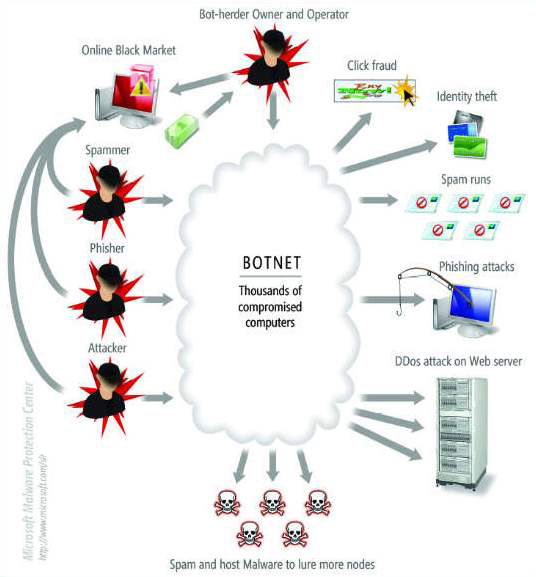Botnets are networks of compromised computers controlled by remote attackers in order to perform such illicit tasks as sending spam or attacking other computers. The word Bot comes from the word Robot and refers to any software program that carries out automated pre-defined tasks. They can perform useful tasks as well as malicious tasks. Webmasters may be familiar with the Google or Bing bot that looks for and crawls fresh content on the Internet.
What is a Botnet

Bots can also act like malware and carry out malicious tasks. They can also be used to assemble a network of computers and then compromise them. These are Computer Botnets and can be controlled remotely by hackers or Bot Herders.
Each computer in the Botnet is called a Node, and it could be any computer anywhere in the world—even yours—if an attacker has managed to surreptitiously install malware on your computer by exploiting vulnerabilities in your operating system or installed software or tricking you into installing it. Such Nodes are then used to spread the malware further, send spam mail, or even attack other computers. Such Botnets are controlled en masse via protocols such as IRC. Some of you may want to learn more about Botnets.
Microsoft Malware Protection Center defines botnet as a network of computers that can be illicitly and secretly controlled at will by an attacker and commanded to take a variety of actions. Under this definition, a trojan downloader that is only designed to download arbitrary files and cannot otherwise be controlled by the attacker would not be considered a bot.

Botnets should be of concern to governments and businesses because they can harness large numbers of individual computers to direct an attack against information technology infrastructure.
Microsoft is aggressively fighting botnets by collaborating with governments and others to take them down. Microsoft also provides businesses, governments, and consumers with security tools and guidance. Working towards this goal, Microsoft has released a document titled Botnets: Guidance for Governments, which can be downloaded at Microsoft.
Infographic
McAfee has created an easy-to-understand Infographic explaining botnets. With the rapid growth in malware and bot infections worldwide, it becomes important for all to understand Botnets and Zombies.

This Infographic nails the botnet lifecycle and economics just right… not too technical, not too simple. Click on it to see the larger image.
Fear that your computer may be a part of a Botnet? Have a look at these Botnet Removal Tools.
This Global Botnet Visualizer keeps you up-to-date on Bot activity. These Botnet Trackers will help you keep track of the Bot activity globally.
Is a botnet attack illegal?
If you or anyone else operates a botnet attack, it’s illegal and mostly punishable by law. While every Botnet attack has a different purpose, a lot of data is stolen, and a lot of time and work is hampered. Imagine a hospital not being able to register incoming patients because the system has been taken down by a botnet attack.
Can a VPN protect you from DDoS?
No, it cannot, but it can hide your primary PC, helping you safeguard the data on the PC. However, the VPN has to include security measures to ensure your data is not compromised.